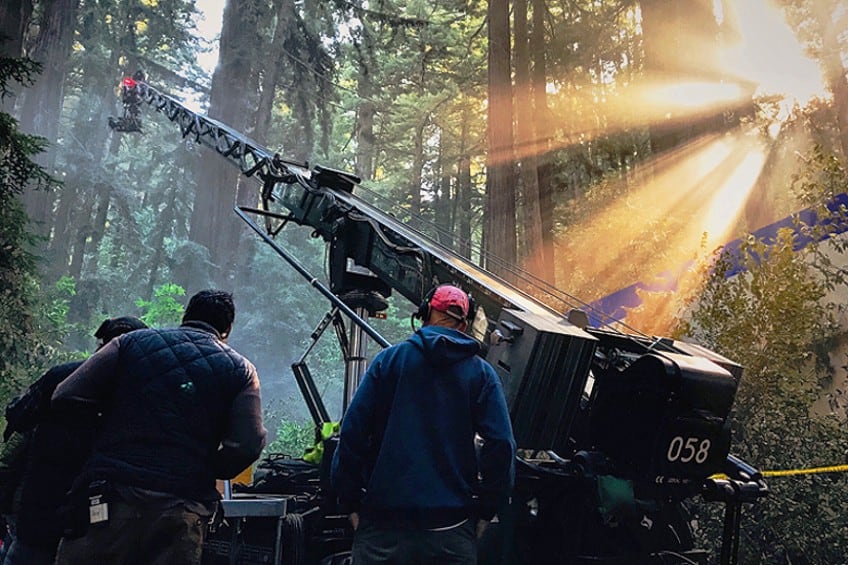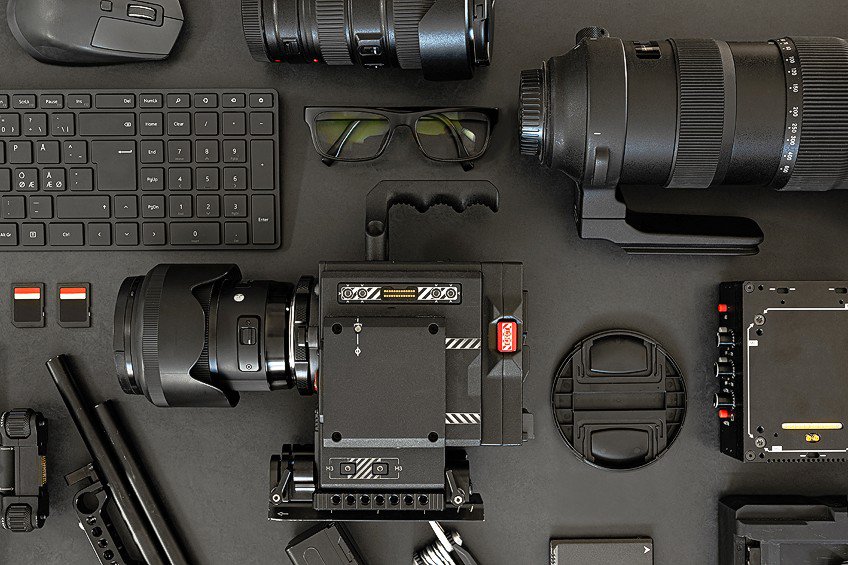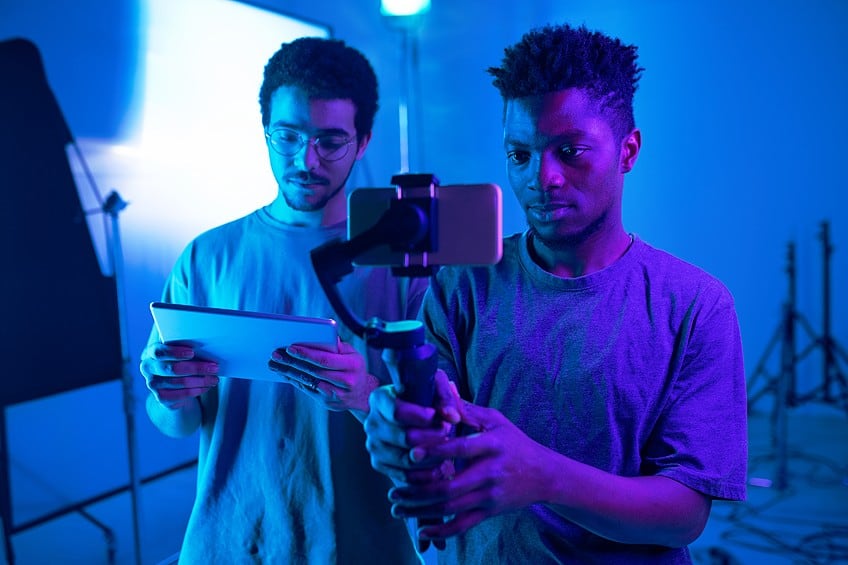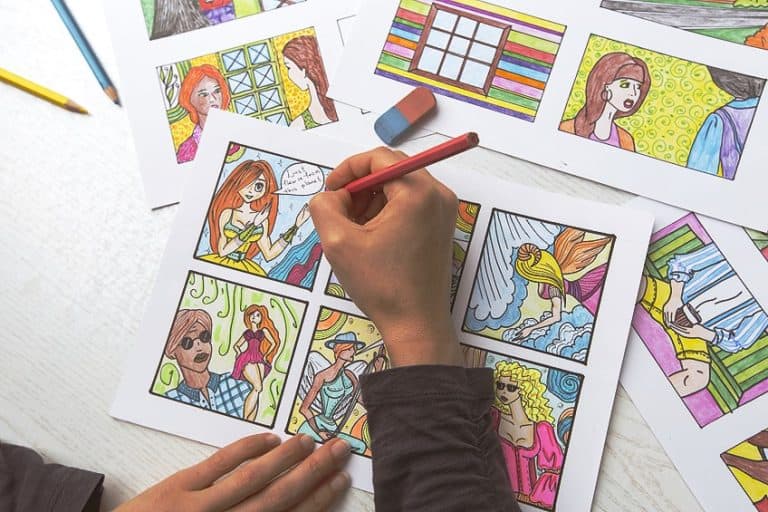How to Make a Movie – The Ins and Outs of a Modern Art Form
In the glittering world of Hollywood, the magic of cinema unfolds with every flicker of light and roll of the camera. Have you ever wondered, “what does it mean to produce a movie?”, or even how to make a movie in the first place? It is truly a mesmerizing journey, one that takes us from behind the scenes to where dreams are woven into celluloid reality. Exploring the intricate tapestry of how movies are made, we will embark on an exhilarating odyssey into the heart of filmmaking, discovering the secrets, creativity, and sheer unrelenting dedication that is needed in order to bring stories to life on the big and small screens.
Pre-Production: Starting With an Idea
Within and throughout the medium of filmmaking, the journey begins long before the cameras start rolling. Ever wondered how movies are made from just a simple idea? This is where the enchanting realm of pre-production takes center stage. To unravel the secrets of how to make a movie, we must first delve into the art of nurturing a cinematic concept into reality. Join us as we embark on a thrilling exploration of the crucial initial steps in the filmmaking process, where creativity sparks and ideas transform into the mesmerizing stories we see on the screen.

The Script
Crafting a script for your short or feature-length film is akin to sculpting a masterpiece from raw stone. It is a vital step in the process of how to make a movie and a cornerstone in understanding how movies are made. As we venture into the beating heart of pre-production and explore how to write your script, we uncover the art of storytelling at its core. Writing a script is more than just putting words on paper; it is about weaving a tapestry of emotions, characters, and dialogue that will resonate with audiences.
It is about crafting vivid scenes that transport viewers to different worlds and eras, igniting their imaginations.
But it is not just about the words themselves; it is also about structure, pacing, and capturing the essence of your vision. In this stage of the filmmaking journey, you become both the architect and the artist, building the foundation upon which your cinematic dream will stand.
The Producer
The role of the producer is similar to that of conducting a grand symphony, orchestrating the elements of pre-production into a harmonious masterpiece. Understanding the pivotal role of the producer is essential when delving into how to produce a movie. As the often unsung architects of cinematic dreams, they are tasked with molding our creative visions into reality. The producer is both a visionary and a pragmatist, turning dreams into reality with a unique blend of creativity and business acumen.

They are in charge of assembling the most suitable talent, while still securing funding and ensuring that every minute facet of the production phase aligns with the director’s vision. From script development to casting, location scouting, and budget management, knowing the ins and outs of how to produce a film is a multifaceted and demanding job. These individuals are the glue that holds any project together, navigating the complex landscape of the film industry to bring stories to life on the silver screen.
The Crew
The selection of your crew members is much like assembling a symphony orchestra. It is a pivotal aspect of pre-production, where the magic of movie-making truly begins to take shape. Choosing the right crew members for your film is an art in itself, as essential as the script and the director’s vision. Each member of the crew plays a unique instrument, contributing their skills and expertise to create a harmonious cinematic masterpiece. From the visionary director and talented cinematographer to the meticulous production designer and dedicated costume department, each role is a brushstroke on the canvas of your film.
The success of your project hinges on the collaborative synergy of these individuals.
It is about finding the right balance of creative minds, technical wizards, and logistical maestros who share your passion and commitment to bring your story to life. As you navigate the labyrinth of pre-production, remember the crew you assemble is not just a team; they are the backbone of your film, the unsung heroes who turn dreams into reality. Their dedication, creativity, and expertise will shape every frame and sound, leaving an unmistakable mark on the cinematic landscape.
The Actors
Similar to finding a rare and precious gem, casting the right actors for your film is a paramount facet of pre-production, where the alchemy of storytelling is able to find its image. Choosing the right actors can be a long and arduous feat, but it is where the characters transcend the pages of the script and come to life with passion, depth, and authenticity. These performers are the heart and soul of your cinematic vision, the vessels through which your narrative finds its voice.

Every nuance of expression, every heartfelt emotion, and every captivating moment hinges on their talent and dedication. Casting is not just about finding individuals who fit the physical attributes of a character; it is about unearthing the souls who can inhabit those roles and breathe life into them. The chemistry between actors can elevate a scene to breathtaking heights and provide your audience with an authentic connection.
The Equipment
Like choosing the tools of an artist’s trade, selecting the right filming equipment should be seen as a pivotal step in the pre-production phase, where the canvas of your cinematic vision begins to take shape. Choosing the right equipment is what sparks a symphony of technical and creative considerations. From the choice of cameras and lenses to lighting setups and audio gears, the equipment you select is the foundation upon which your visual storytelling methods will flourish.
It is about matching the technology to your artistic vision, ensuring every frame captures the essence of your story.
The decision-making process is a delicate balance between practicality and creativity. It involves understanding the nuances of each piece of equipment and how it can best serve your narrative. Whether you opt for the intimate charm of handheld cameras or the grandeur of cinematic drones, each choice contributes to the visual identity of your film.
Production: Bringing Your Idea to Life
The production phase of filmmaking is where the dreams and visions of the scriptwriter and director come to life. It is the creatively technical process of transforming ideas into moving images, where every frame pulses with creativity and craftsmanship. From script to set, from actors to artistry, this phase is a symphony of collaboration, dedication, and sheer creative skill.

The Director
Once you step onto your film set, you will find that the director is a sort of master weaver, a visionary conductor, and even the guiding star of the entire project. Their role is nothing short of cinematic alchemy, as they breathe life into the script’s words, transforming them into a visual and emotional spectacle. With an artist’s eye and a strategist’s mind, directors sculpt the narrative, mold characters, and choreograph every scene with meticulous precision. But their role transcends mere technicality; it is a blend of psychology and intuition, diplomacy, and authority.
A director is the bridge between imagination and reality, coaxing authentic performances from actors, while harmonizing the symphony of cinematography, sound, and design.
They are storytellers at heart, painting tales on the canvas of celluloid, evoking laughter, tears, and suspense from the audience. A director’s creative fingerprint should grace every frame, every line of dialogue, and every whisper of music. They are the cinematic architects, crafting worlds and emotions that captivate our hearts and minds.
The Cinematographer
The cinematographer wields the power of visual storytelling like a virtuoso. Their role is a delicate dance between art and technology, where every frame is a brushstroke on the canvas of cinema. Otherwise referred to as the director of photography, the cinematographer is the maestro of lighting, frame composition, and camera movement. They shape the film’s visual identity, painting with light to convey emotion and atmosphere. With an artist’s eye, they capture the nuances of a scene, translating the director’s vision into stunning images.

From sweeping, breathtaking landscapes to intimate, emotive close-ups, their lens is the conduit through which the audience experiences the film’s oil. Yet, their craft extends beyond aesthetics; it is a symphony of technical prowess. They navigate complex camera equipment, harness the subtleties of color grading, and collaborate closely with the director to ensure a cohesive visual narrative.
The Production Sound Mixer
In the creative realm where storytelling hinges not only on what we see but what we hear, the production sound mixer emerges as yet another unsung hero within filmmaking, sculpting the auditory landscape of cinema. This maestro of sound navigates the intricate web of microphones, wires, and recording equipment, all while capturing the purest essence of dialogue, ambiance, and emotion on set. The role of a production sound mixer is a symphony of technical precision and artistic finesse.
They orchestrate a delicate balance between dialogue and the ambient sounds that breathe life into scenes, ensuring every word is crystal clear, every rustle, every whisper, every heartbeat resonates with authenticity.
Their expertise extends beyond equipment, as they collaborate seamlessly with the director, actors, and crew to capture the perfect sonic tapestry. Their finely tuned ears detect nuances in sound that most would overlook, ensuring that the audience is not just watching, but fully immersed in the cinematic world unfolding before their eyes and ears.
The Set Designer
In the world of filmmaking, the role of the set designer is nothing short of enchantment, as they are able to transform mere locations into immersive worlds that transport audiences into the heart of the narrative. Much like any other role within filmmaking, the set designer is a master storyteller in their own right, translating the director’s vision into tangible, three-dimensional spaces. With an artist’s eye for detail and a visionary’s imagination, they breathe life into every set piece, every prop, and every backdrop.
Whether it is a bustling cityscape, a whimsical fairy tale forest, or a gritty post-apocalyptic wasteland, their creative genius knows no bounds. Their work extends beyond aesthetics; it is a fusion of artistry and practicality. Set designers collaborate closely with directors, cinematographers, and costume designers to ensure a seamless visual narrative. Their sets become the canvas upon which the characters evolve, the backdrop against which emotions unfold.
Post-Production: Finalizing the Filmmaking Process
Within the mesmerizing journey that is the filmmaking process, reaching the post-production phase marks the beginning of the end, where raw footage transforms into a polished masterpiece. It is the alchemical crucible where editing, visual effects, sound design, and music orchestrate a symphony of storytelling.
Post-production weaves together the threads of a cinematic tapestry, infusing it with emotion, rhythm, and a touch of pure magic.
Editing
At the heart of the post-production phase, we have the editing process, where the film’s narrative finds its rhythm, pacing, and emotional depth. The editor, armed with a keen eye and an intuitive sense of storytelling, becomes the cinematic conductor, orchestrating each scene with precision. Editing is the dance of juxtaposition, where disparate shots seamlessly blend to create a cohesive whole. It is where the director’s vision, the cinematographer’s artistry, the actors’ performances, and the efforts of the entire film crew fuse together into a single visual symphony.

Through a delicate interplay of cuts, transitions, and visual effects, editors breathe life into the story, evoking laughter, tears, and suspense. But editing is more than technical finesse; it is an act of narrative alchemy. It is the art of revealing the story’s essence, of distilling hours of footage into a tight, compelling tale. In the post production phase, editing is the magic wand that transforms mere scenes into moments of cinematic brilliance, where every frame carries the weight of storytelling history.
Special Effects
Once your editor has reached a certain point within the first few drafts of the film’s cut, the magic truly comes alive as the visual effects (VFX) artists step into the spotlight, weaving enchantment into every frame. Their role is akin to that of modern-day wizards, conjuring the extraordinary from the plain ordinary. VFX transports audiences to distant galaxies, summon mythical creatures, and turn the mundane into the fantastical. The VFX artist’s canvas is found in the digital realm, where imagination knows no bounds. With cutting-edge technology and boundless creativity, they sculpt digital landscapes, craft otherworldly creatures, and unleash the forces of nature.
Yet, their work goes beyond spectacle; it is a meticulous fusion of art and science. They seamlessly integrate their creations with live-action footage, making the impossible appear utterly plausible.
In post-production, visual effects artists are the architects of cinematic wonder, transferring the ordinary into the extraordinary. They transport us to uncharted realms, making the fantastic feel like home. With each pixel and every frame, they breathe life into the director’s wildest dreams, leaving audiences spellbound by the sheer magic of their craft. Post-production, with its dazzling special effects, is where imagination takes flight, and the boundaries of reality dissolve into a world of endless possibilities.
Sound Mixing
Once you reach a certain point in the post-production phase, sound mixing is seen as the symphony’s final crescendo, elevating a film from mere visuals to an immersive auditory journey. Sound mixers are the virtuosos of this phase, crafting every sonic element with meticulous precision to ensure that every whisper, every note, and every ambient sound resonates with emotional depth. In the hands of a skilled sound mixer, sound becomes a character in its own right, enhancing storytelling to an elemental level. They harmonize dialogue, music, and sound effects, forging a sonic landscape that envelopes the audiences, stirring emotions and suspending disbelief.

The art of sound mixing is a delicate alchemy that balances technical mastery with artistic intuition. It is about crafting the perfect blend of sound elements, ensuring that the viewer is not just watching but experiencing the film with every sense. From the subtlest rustle of clothing to the thunderous roar of an explosion, sound mixers breathe life into the film’s auditory realm. In post-production, sound mixers are the poets of cinema, enriching the narrative with layers of emotion, tension, and atmosphere. Their artistry, while often unnoticed, transports audiences into the heart of the story, making every moment unforgettable. Sound mixing is where cinema transcends the visual, resonating deep within the soul, and leaving an unmistakable imprint long after the credits roll.
Sharing Your Work With the World
Once you have reached the once seemingly elusive final cut of your film, sharing it with the world does not have to break the bank. In an era of accessible technology and innovative distribution methods, there are numerous cost-effective ways to ensure your cinematic labor of love reaches its audiences.
Here, we delve into several strategies for sharing your indie film with the world affordably.
Online Streaming Platforms
One of the most affordable and accessible options for indie filmmakers is to leverage online streaming platforms. Services like YouTube and Vimeo offer free or low-cost options for uploading and sharing your film with a global audience. With a strategic marketing plan, you can reach viewers interested in your genre or style without significant, or even any, financial investment.

Additionally, consider platforms like Tubi, Crackle, or Popcornflix, which specialize in indie and lesser-known films. These platforms may offer revenue-sharing opportunities based on the number of views your film receives.
Film Festivals and Online Submissions
While some film festivals charge submission fees, many indie-focused festivals offer affordable options for showcasing your work. Research festivals that align with your film’s genre or themes and have lower entry fees.
Winning or screening at these festivals can garner attention from distributors or increase your film’s visibility.
Additionally, consider virtual festivals and online platforms that specialize in indie films. These digital events often have lower submission costs and while still allowing you to reach global audiences.
Film Collaboratives and Collectives
Joining or forming a film collaborative or collective can be a cost-effective way to share your indie film. These groups open pool resources, talent, and knowledge to create and distribute films collectively. By sharing equipment, marketing efforts, and distribution strategies, you can reduce individual expenses and tap into a network of like-minded creators.

Social Media and Crowdsourcing
Harness the power of social media to promote your indie film inexpensively. Create engaging content, including trailers, behind the scenes glimpses, and teasers, and share them across various social platforms such as Facebook, Twitter, Instagram, and TikTok.
Building a dedicated following can generate buzz and word-of-mouth marketing.
Crowdsourcing platforms like Kickstarter and Indiegogo allow you to raise funds for your film’s distribution and marketing efforts. With a compelling pitch and enticing rewards for backers, you can secure financial support from your audience. Crowdfunding also serves as a marketing tool, as backers become invested in the success of your project.
DIY Screenings and Local Events
Host DIY screenings of your indie film in local theaters, community centers, or outdoor venues. Partner with local businesses or organizations to co-host screenings and share the costs. Charging a nominal admission fee or accepting donations can help recoup expenses and build an audience in your community.

Collaborate with film clubs, art houses, or cultural centers to showcase your work at their events. These venues often have lower or no rental fees, making it easier to screen your film to diverse audiences.
General Tips and Tricks for the Up-and-Coming
Becoming a successful filmmaker while starting in the indie scene can be a challenging but immensely rewarding journey. It is a world where creativity knows no bounds, and innovation often outshines big budgets.
Here are some invaluable tips and tricks for up-and-coming indie filmmakers looking to make their mark on the industry.
Start Small, Dream Big
As an indie filmmaker, your resources may be limited, but your imagination is not. Begin with manageable projects that align with not only your budget, but available resources and equipment too. Short films, web series, or micro-budget features can be excellent starting points to showcase your talent and build your portfolio.

Invest in Storytelling
Regardless of your budget, a compelling story is your greatest asset. Spend time honing your screenplay, focusing on character development, plot structure, and emotional resonance. A strong script can captivate viewers, even without Hollywood-level production values.
Embrace Creativity in Limitations
Limited resources can be a source of innovation. Rather than seeing budget constraints as obstacles, view them as opportunities to think outside the box. Find creative solutions for challenges like props, locations, and special effects.
Use the uniqueness of your circumstances to create a distinctive cinematic style.
Utilize Free and Low-Cost Resources
Take advantage of free or low-cost resources available to indie filmmakers. Public locations, open-source software, and royalty-free music and sound effects can reduce expenses to a significant degree. Tap into local film commissions and grants that support independent filmmakers.

Embrace Technology
In today’s digital age, affordable filmmaking equipment and software are readily available. Invest in quality cameras, sound recording equipment, and editing software to enhance your production values.
Familiarize yourself with the latest filmmaking technology and techniques to stay competitive.
Assemble a Dedicated Team
Surround yourself with passionate and talented individuals who share your vision. Collaborate with committed actors, crew members, and producers who believe in your project. A dedicated team can elevate your work and help overcome obstacles.

Previsualization Is Key
Storyboarding and shot lists can save time and money during production. Plan your shots meticulously to ensure you capture the visuals you envision. Previsualization can also help convey your ideas to your team and make the most of your shooting days.
Stay True to Your Vision
While collaboration is essential, never sight of your own unique voice and vision as a filmmaker. Trust your instincts and make choices that align with your creative goals. Authenticity is a powerful asset in indie filmmaking.
Focus on Post-Production Quality
Post-production is where your film truly comes to life. Invest time and effort in professional editing, sound design, color grading, and visual effects. A polished final product can elevate your indie film to a higher standard and enhance its marketability.
Keep Creating
The most successful indie filmmakers are those who consistently produce new work. Keep creating, experimenting, and evolving as a filmmaker. Each project is an opportunity to learn and grow in your craft.

Persistence and Resilience
The path to success in the film scene is rarely linear. Be prepared to encounter setbacks, rejection, and moments of self-doubt. Persistence and resilience are your allies, so keep refining your craft, learning from experiences, and pushing forward.
Learn from Feedback
Be open to feedback from peers, mentors, and audiences. Constructive criticism can help you grow as a filmmaker. Attend screenings of your work and engage in discussion to gain valuable insights.

In the film scene, whether indie or high-budget, it is passion, determination, and a strong work ethic that can help to propel you forward. Remember that success may not happen overnight, but by knowing how to produce a movie, as well as staying consistent and passionate, amongst the countless other roles that lie within the orchestra that is filmmaking, success is only a matter of time. By imbedding these core traits as a filmmaker, you will be able to transform your dreams into cinematic reality, taking audiences on unforgettable storytelling adventures!
Frequently Asked Questions
What Does It Mean to Produce a Movie?
Knowing how to produce a movie means being responsible for overseeing all aspects of a film’s production, from securing funding and hiring key personnel to managing the budget and ensuring the project stays on schedule. Producers play a crucial role in bringing a film from concept to completion.
How Can I Come Up With a Compelling Movie Idea or Concept?
Movie ideas can come from anywhere: personal experiences, books, news articles, dreams, or simply your imagination! Start by brainstorming concepts that resonate with you and explore how they can be developed into a captivating story.
Do I Need a Big Budget to Make a Movie?
No, you can make a movie on a variety of budgets. Independent films often have lower budgets and can still be highly successful if the storytelling is strong. Your budget will influence the scale and resources available for your project, but creativity and resourcefulness can go a long way in filmmaking.
Duncan completed his diploma in Film and TV production at CityVarsity in 2018. After graduation, he continued to delve into the world of filmmaking and developed a strong interest in writing. Since completing his studies, he has worked as a freelance videographer, filming a diverse range of content including music videos, fashion shoots, short films, advertisements, and weddings. Along the way, he has received several awards from film festivals, both locally and internationally. Despite his success in filmmaking, Duncan still finds peace and clarity in writing articles during his breaks between filming projects.
Duncan has worked as a content writer and video editor for artincontext.org since 2020. He writes blog posts in the fields of photography and videography and edits videos for our Art in Context YouTube channel. He has extensive knowledge of videography and photography due to his videography/film studies and extensive experience cutting and editing videos, as well as his professional work as a filmmaker.
Learn more about Duncan van der Merwe and the Art in Context Team.
Cite this Article
Duncan, van der Merwe, “How to Make a Movie – The Ins and Outs of a Modern Art Form.” Art in Context. November 9, 2023. URL: https://artincontext.org/how-to-make-a-movie/
van der Merwe, D. (2023, 9 November). How to Make a Movie – The Ins and Outs of a Modern Art Form. Art in Context. https://artincontext.org/how-to-make-a-movie/
van der Merwe, Duncan. “How to Make a Movie – The Ins and Outs of a Modern Art Form.” Art in Context, November 9, 2023. https://artincontext.org/how-to-make-a-movie/.









